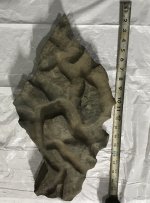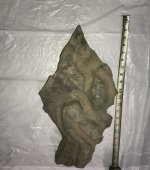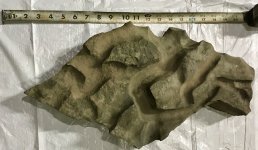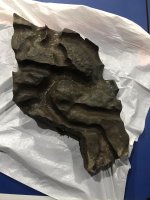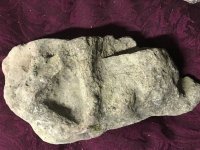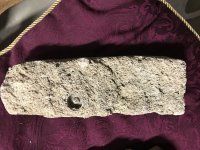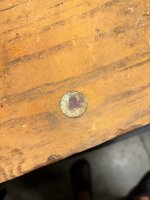You are using an out of date browser. It may not display this or other websites correctly.
You should upgrade or use an alternative browser.
You should upgrade or use an alternative browser.
Rock or fossil
- Thread starter ADC
- Start date
Red-Coat
Gold Member
Welcome to the forum.
Those patterns in the first pictures could well be feeding traces from mud burrowing critters in a sediment that has lithified. It looks like what is generally referred to as mudstone or siltstone. Those kinds of traces are typically made by bivalve molluscs and, as trace fossils, we call them 'ichnofossils'.
In the second set of pictures, I see nothing unusual in the first picture other than a broken sedimentary rock with some erosion features. The latter specimen appears to be oolitic limestone, and it seems to have the end-on impression of a fossil crinoid columnal (that circular feature with a smaller circle within it). Crinoids of this type have a columnar stem terminating in a bud with feeding arms that give them a plant-like appearance... hence the popular name of 'sea-lilies', although they're marine animals loosely related to starfish and sea urchins.
Those patterns in the first pictures could well be feeding traces from mud burrowing critters in a sediment that has lithified. It looks like what is generally referred to as mudstone or siltstone. Those kinds of traces are typically made by bivalve molluscs and, as trace fossils, we call them 'ichnofossils'.
In the second set of pictures, I see nothing unusual in the first picture other than a broken sedimentary rock with some erosion features. The latter specimen appears to be oolitic limestone, and it seems to have the end-on impression of a fossil crinoid columnal (that circular feature with a smaller circle within it). Crinoids of this type have a columnar stem terminating in a bud with feeding arms that give them a plant-like appearance... hence the popular name of 'sea-lilies', although they're marine animals loosely related to starfish and sea urchins.
Upvote
0
Users who are viewing this thread
Total: 2 (members: 0, guests: 2)
